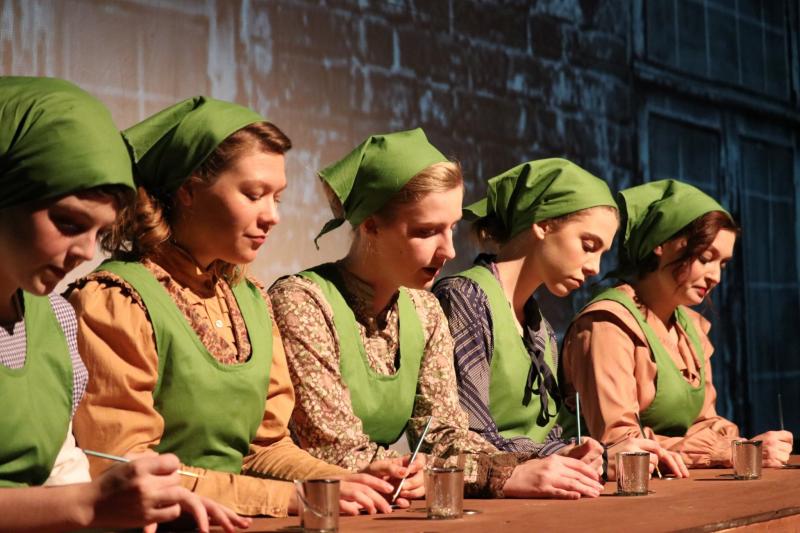Review: RADIUM GIRLS at Midland University Kimmel Theatre is Sobering

RADIUM GIRLS, D.W. Gregory's sobering play based on real events is onstage at the Kimmel Theatre on Midland University campus. Yellowed newspaper articles about the Radium Girls, photographs, and copies of luminous watch faces and drinks are on display in the lobby, getting us prepared for the story to come. And let me tell you: this is one not to miss.
The "Radium Girls" were young women employed by facilities in the United States who produced luminous dials for watches. The women contracted radiation poisoning from painting the watch dials, dipping the tips of their brushes on their lips to keep them pointed. These women were not aware of the danger, and also used the paint to do their nails, teeth, and faces. Over time they began to suffer from anemia and gross necrosis of the jaw, which was discovered during dental visits for toothache and seepage from their gums. Corporate management denied all culpability and intentionally misattributed the disease to syphilis. Dr. Von Sohocky, inventor of the luminous paint, also eventually died from radiation poisoning.
In the early 1920s scientists touted radium as a miracle cure. Madame Curie was an international celebrity back then, having discovered radium with her husband Pierre in 1898. Radium was then believed to cure cancer and was marketed as a health tonic.
This play follows historical events with reasonable accuracy. Grace Fryer, the young woman who contracted radiation poisoning herself, took the U.S. Radium Corporation to court. Fighting a steep uphill battle, she was instrumental in the eventual passage of the Occupational Disease Labor Law and the right of individuals to sue corporations for damages due to labor abuse. But it was a long and painful journey unsupported by her family who pressured her to take whatever money was handed to her in trade for her silence.
Two acts, 26 scenes, and 21 actors carry out this story that covers the years 1920 through 1933. Heading the cast are Alejandra Garcia as Grace, Alex Law as Arthur Roeder, (Director of the U.S. Radium Corporation), and Molly Rutz as Grace's friend and coworker Kathryn. Their performances, and those of the other Radium Girls, moved me as they suffered on stage, both physically in the case of the young women, and mentally in the case of Arthur as he wrestles with right and wrong.

Alana Roberg is quite good as Arthur's wife, Diane. She is his support, but she is also his moral compass. Chris Lopez, as C.B. "Charlie" Lee comes across strong and boisterous with a great deal of confidence. The women journalists break up the seriousness of the story with animated patter. The entire cast does a wonderful job recreating this piece of sad history that appeals to our compassion but stops at morbidity. Lee Meyer does a fine job directing.
Daniel Silverman's set is minimalist, but effective, amplified by Travis Crafe-Cline's and Taylor Zylstra's projections of black and white houses, and illuminated with lights by Pierce Bonacci-Johnson. The dream scene with Marie Curie, Kathryn, and Grace is mesmerizing with its color and effects. Costume Designers Eric Rajanieme and Lee Meyer do an especially fine job with costuming. In particular, Diane's detailed gray dress is eye-catching and I wondered if they had built it or discovered it in a vintage shop. Either way, it is just the cherry on top of some very nice costumes.
Kudos to the cast and crew for a play that goes above the norm. History needs to be told. We can learn from it and what better way than to watch it in front of us?
Performances OCT 10-13, 2019
Photos courtesy of Midland University Theatre
Reader Reviews
Videos

